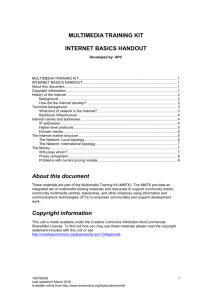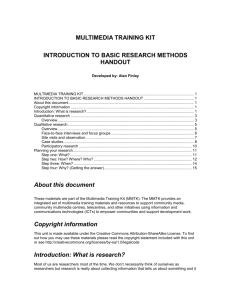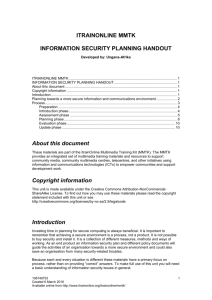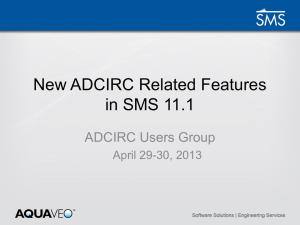Mesh Networks - ItrainOnline
advertisement
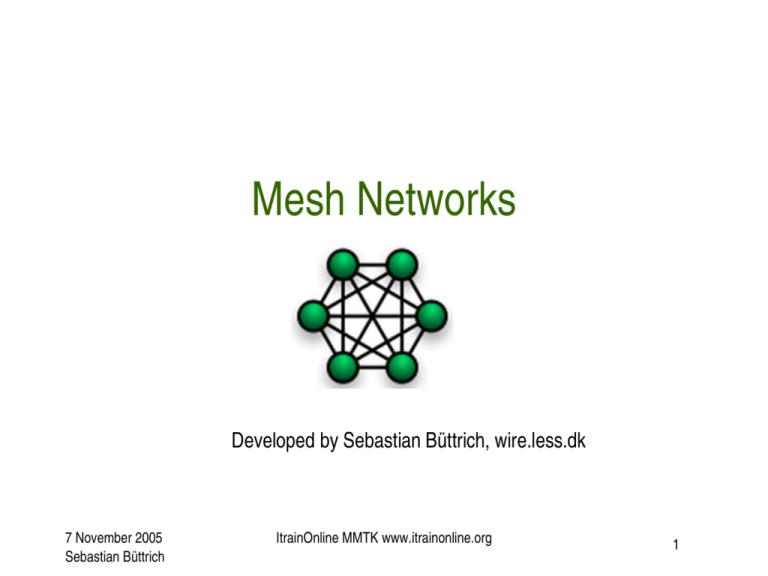
Mesh Networks Developed by Sebastian Büttrich, wire.less.dk 7 November 2005 Sebastian Büttrich ItrainOnline MMTK www.itrainonline.org 1 Session overview • Mesh topology • Motivations, expectations and limitations • Mesh routing protocols • Mesh hardware • Mesh oriented software • Mesh case stories • Issues in mesh networking 7 November 2005 Sebastian Büttrich ItrainOnline MMTK www.itrainonline.org 2 Mesh topology ­ definition • A mesh network is a network that employs one of two connection arrangements, full mesh topology or partial mesh topology. In the full mesh topology, each node is connected directly to each of the others. In the partial mesh topology, nodes are connected to only some, not all, of the other nodes." 7 November 2005 Sebastian Büttrich ItrainOnline MMTK www.itrainonline.org 3 Mesh topology ­ definition • Mesh, the simple way: 7 November 2005 Sebastian Büttrich ItrainOnline MMTK www.itrainonline.org 4 Mesh topology ­ definition: full & partial mesh Mesh topology – what it is not (necessarily): dynamic • Nothing is necessarily dynamic in a mesh. However, in recent years, and in connection with wireless networks, the term "mesh" is often used as a synonym for "ad hoc" or "mobile" network. Obviously, combining the two characteristics of a mesh topology and ad hoc capabilities is a very attractive proposition. 7 November 2005 Sebastian Büttrich ItrainOnline MMTK www.itrainonline.org 6 Mesh topology – a common understanding • Mesh network ­ a network that handles many­to­many connections and is capable of dynamically updating and optimizing these connections. 7 November 2005 Sebastian Büttrich ItrainOnline MMTK www.itrainonline.org 7 Mesh topology – a typical scenario 7 November 2005 Sebastian Büttrich ItrainOnline MMTK www.itrainonline.org 8 Mesh topology – related terms • MANET (mobile ad hoc network) • Ad hoc network • Multi­Hop­Networks 7 November 2005 Sebastian Büttrich ItrainOnline MMTK www.itrainonline.org 9 Mesh networks – Motivations & expectations: why Mesh? • Reality is not regular • Low­cost (potentially) • Distributed ownership models • Gradual deployment of infrastructure • Simplicity • Robustness • Low power requirements per unit Mesh networks – motivations & expectations • Reality fit Reality rarely comes as a star, ring, or a straight line. In difficult terrain ­ be that urban or remote ­ where not every user can see one or few central points, chances are she can see one or more neighbouring users. 7 November 2005 Sebastian Büttrich ItrainOnline MMTK www.itrainonline.org 11 Mesh networks – motivations & expectations • Price The fact that each mesh node runs both as a client and as a repeater potentially means saving on the number of radios needed and thus the total budget. While this point loses relevance with dropping radio prices, more importantly, mesh approaches can reduce the need for (expensive and vulnerable) central towers and other centralized infrastructure. 7 November 2005 Sebastian Büttrich ItrainOnline MMTK www.itrainonline.org 12 Mesh networks – motivations & expectations • Organization and business models The decentralized nature of mesh networks lends itself well to a decentralized ownership model wherein each participant in the network owns and maintains their own hardware, which can greatly simplify the financial and community aspects of the system. 7 November 2005 Sebastian Büttrich ItrainOnline MMTK www.itrainonline.org 13 Mesh networks – motivations & expectations • Ease and simplicity For a device that is pre­installed with wireless mesh software and uses standard wireless protocols such as 802.11b/g, the setup is extremely simple. Since routes are configured dynamically, it is often enough to simply drop the box into the network, and attach whatever antennas are required for it to reach one or more existing neighboring nodes (assuming that we can solve the issue of IP address allocation). 7 November 2005 Sebastian Büttrich ItrainOnline MMTK www.itrainonline.org 14 Mesh networks – motivations & expectations • Network robustness The character of mesh topology and ad­hoc routing promises greater stability in the face of changing conditions or failure at single nodes, which will quite likely be under rough and experimental conditions. 7 November 2005 Sebastian Büttrich ItrainOnline MMTK www.itrainonline.org 15 Mesh networks – motivations & expectations • Power The substrate nodes of a mesh network ­ possibly excepting those nodes that maintain an up­link to the Internet ­ can be built with extremely low power requirements, meaning that they can be deployed as completely autonomous units with solar, wind, hydro, fuel cell or human generated power. 7 November 2005 Sebastian Büttrich ItrainOnline MMTK www.itrainonline.org 16 Mesh networks – motivations & expectations • Power Piggybacking mesh networks on projects that primarily aim at energy production might be a very feasible strategy ­ with every panel or windmill, a node. Power generating units are typically connected to points of infrastructure and human presence. This makes them valid locations for network nodes. As a secondary benefit, the presence of integrated network nodes within power networks may allow for better monitoring and management. 7 November 2005 Sebastian Büttrich ItrainOnline MMTK www.itrainonline.org 17 Mesh networks – motivations & expectations • Integration Mesh hardware has all advantages of embedded technology: it is typically small, noiseless, and easily encapsulated in weatherproof boxes. This means it also integrates nicely outdoors as well as in human housing. 7 November 2005 Sebastian Büttrich ItrainOnline MMTK www.itrainonline.org 18 Mesh networks – motivations & expectations • Until now, mesh networks have most often proposed for urban scenarios and unicipality networks • But there is big potential for rural and remote connectivity scenarios 7 November 2005 Sebastian Büttrich ItrainOnline MMTK www.itrainonline.org 19 Mesh networks – motivations & expectations • Mesh routing protocols: elements of mesh routing • • • • • • Node discovery Border discovery Link metrics Route calculation IP address management Uplink/backhaul management 7 November 2005 Sebastian Büttrich ItrainOnline MMTK www.itrainonline.org 21 Mesh routing protocols: Types • Pro­active (Table­driven) Proactive checking of Link state and updating of routing tables – high complexity and CPU load, high performance • Reactive (On­demand) Reacting on detection problems (non­working routes) – less demanding on CPU • Lines between types are not strict • More and mixed types exist 7 November 2005 Sebastian Büttrich ItrainOnline MMTK www.itrainonline.org 22 Mesh routing protocols: Metrics • Metric calculation deals with the cost assigned to a certain route • In principle, the routing protocol is independent from the metrics calculation – it just needs to know how 'good' the route is, not where that value comes from • Yet sensible metrics are the core of wireless ad hoc networking 7 November 2005 Sebastian Büttrich ItrainOnline MMTK www.itrainonline.org 23 Mesh routing protocols: Pro­active (Table­driven) • OLSR (Optimized Link State Routing Protocol)OLSR­ EXT, QOLSR • TBRPF (Topology Broadcast based on Reverse­Path Forwarding routing protocol) • HSLS (Hazy Sighted Link State routing protocol) • MMRP (Mobile Mesh Routing Protocol), short: MobileMesh • OSPF (Open Shortest Path First) 7 November 2005 Sebastian Büttrich ItrainOnline MMTK www.itrainonline.org 24 Mesh routing protocols: Reactive (On­demand) • AODV 7 November 2005 Sebastian Büttrich ItrainOnline MMTK www.itrainonline.org 25 Mesh routing protocols: MMRP (MobileMesh) • Mobile Mesh protocol contains three separate protocols, each addressing a specific function 1. Link Discovery – a Simple “Hello” Protocol 2. Routing ­ Link State Packet Protocol 3. Border Discovery ­ Enables external tunnels • Developed by Mitre (with military interest involved) • The Mobile Mesh software is covered by the GNU General Public License (Version 2) • Comment: MobileMesh is a ood starting point for educational experiments, e.g. With Linux laptops 7 November 2005 Sebastian Büttrich ItrainOnline MMTK www.itrainonline.org 26 Mesh routing protocols: OSPF • Open Shortest Path First (OSPF) developed by the Interior Gateway Protocol (IGP) working group of the IETF , based on the SPF algorithm • OSPF specification is in the public domain, published as RFC1247. • Calls for the sending of link­state advertisements (LSAs) to all other routers within the same hierarchical area. Information on attached interfaces, metrics used, and other variables included in LSAs. • OSPF routers accumulate link­state information, use the SPF algorithm to calculate shortest paths • As a link­state routing protocol, OSPF contrasts (and competes) with RIP and IGRP, which are distance­vector routing protocols. Routers running the distance­vector algorithm send all or a portion of their routing tables in routing­update messages to their neighbors. 7 November 2005 Sebastian Büttrich ItrainOnline MMTK www.itrainonline.org 27 Mesh routing protocols: OLSR • Optimized Link State Routing protocol. RFC3626. • OLSR is a routing protocol for mobile ad­hoc networks. The protocol is pro­ active, table driven and utilizes a technique called multipoint relaying (MPR) for message flooding. Currently the implementation compiles on GNU/Linux, Windows, OS X, FreeBSD and NetBSD systems. • OLSRD is ment to be a well structured and well coded implementation that should be easy to maintain, expand and port to other platforms. The implementation is RFC3626 compliant with respect to both core and auxiliary functioning. • One of the most promising and stable prorocols • 7 November 2005 Sebastian Büttrich ItrainOnline MMTK www.itrainonline.org 28 Mesh routing protocols: OLSR with ETX • ETX developed at MIT • The Expected Transmission Count (ETX) path metric is a simple, proven routing path metric that favours high­capacity, reliable links. The ETX metric is found from the proportion of beacons sent but not received in both directions on a wireless link. • In practical experiments, the (in)stability of routing tables (how often do we change? How often do we change gateway?) proves to be most critical. • Most metrics calculation concepts are based on 'minimization of hop counts', a wired concept which is inappropriate for wireless networks. ETX adds more 'reasonable' behaviour under real life conditions, by basing metrics on packet loss and thus number of packets sent. • As most other protocols, link metrics are in principle independent of routing protocol and vice versa (transparency). Thus, ETX may be used in combination with various routing protocols. 7 November 2005 Sebastian Büttrich ItrainOnline MMTK www.itrainonline.org 29 Mesh routing protocols: AODV • The Ad hoc On Demand Distance Vector (AODV) protocol is a routing protocol designed for mobile ad hoc networks. ...enables dynamic, self­ starting, multihop routing between computers. • The protocol is in the process of being standardized at the IETF and currently is an experimental RFC • The AODV@IETF project is made possible through the joint collaboration of the MOMENT and NMSL laboratories at UC Santa Barbara and Intel R&D. 7 November 2005 Sebastian Büttrich ItrainOnline MMTK www.itrainonline.org 30 Mesh routing protocols: proprietary extensions • Based on protocols described, many commercial players develop their (proprietary or open) versions • Combinations with extended management software, aiming at higher Quality of Service 7 November 2005 Sebastian Büttrich ItrainOnline MMTK www.itrainonline.org 31 • Mesh hardware Ranges from (almost no­cost) refurbished computers over modified home user Access points for USD 50 to mid­price embedded boards to carrier grade equipment for several thousand USD • Challenge: to balance TCO (total cost of ownership), quality, requirements – as with all other network hardware. • Market is in dynamic development • Open platforms and standards enable open development 7 November 2005 Sebastian Büttrich ItrainOnline MMTK www.itrainonline.org 32 Mesh hardware: 4G AccessCube • dimensions: small cube (7x5x7cm) • low power consumption (ca. 4­6W) • 100Mbps ethernet • power over ethernet (802.3af standard) • up to 2 (4,6) WLAN (802.11a/b/g) interfaces (RP­SMA connectors) • 400MHz MIPS processor • 32MB flash, 64MB RAM • USB • Circa EUR 200 (out of production by 2006!) 7 November 2005 Sebastian Büttrich ItrainOnline MMTK www.itrainonline.org 33 Mesh hardware: Meshnode • Standard model comes with a 266mhz, 128mb ram, 64mb cf card, POE powered board. • It includes 2 minipci cards (Senao 2,4GHz(b/g) and Atheros 5GHz(a/b/g)), four antennas • Built into a waterproof outdoor enclosure. Mesh hardware: Linksys WRT54G • Not originally meant as a mesh device • Due to low price and GPL firmware, one of the most interesting and versatile low budget options • Many firmware distributions available: OpenWRT, EWRT, Batbox, Sveasoft, FreifunkFirmware, and many more • Hardware specs: WRT54G v2 WRT54GS BCM4712KPB • RAM / Flash / CPU speed 16 4 200 MHz 32 8 200 MHz Processor: Price: circa EUR 60 (WRT54G) / 70 (WRT54GS) 7 November 2005 Sebastian Büttrich ItrainOnline MMTK www.itrainonline.org 35 Mesh hardware: Locustworld MeshAP • 500mhz processor, 128mb ram, on board WiFi, 32mb compact flash drive. • No moving parts! • £250 each or £220 in orders of 10+ 7 November 2005 Sebastian Büttrich ItrainOnline MMTK www.itrainonline.org 36 Mesh hardware: any old laptop will do! • Any old laptop or stationary PC can serve as a mesh node • Targetted software packages for this exist: Pebble Linux, MeshLinux, .. • Basically any Linux system can be a basis • Arguments pro/contra using refurbished hardware 7 November 2005 Sebastian Büttrich ItrainOnline MMTK www.itrainonline.org 37 Mesh software packages • Presenting a mix of distributions, packages, software collections of different kinds • All represent good starting points for mesh experiments/implementations • Focus on Free Software 7 November 2005 Sebastian Büttrich ItrainOnline MMTK www.itrainonline.org 38 Mesh software packages: MeshLinux • • • • By Elektra, Berlin/Germany Based on Slackware, circa 50 MB ISO Targetted at reuse of (older) laptops Mesh protocols included: MobileMesh, OLSR, BGP, OSPF, RIP, AODV 7 November 2005 Sebastian Büttrich ItrainOnline MMTK www.itrainonline.org 39 Mesh software packages: Zebra/Quagga • By Kunihiro Ishiguro • GNU Zebra is free software that manages TCP/IP based routing protocols. Part of the GNU Project, distributed under the GNU GPL • Mesh protocols included: BGP­4 (RFC1771, A Border Gateway Protocol 4), RIPv1, RIPv2, OSPFv2, IPv6 ready. • Fork: Quagga adds RIPv3, OSPFv3 7 November 2005 Sebastian Büttrich ItrainOnline MMTK www.itrainonline.org 40 Mesh software packages: CuWin • By Champaign­Urbana community project, USA • “The software the Champaign­Urbana Community Wireless Network (CUWiN) project releases is a complete operating system for wireless, meshing nodes. We start with a stock NetBSD distribution and add wireless drivers, routing code, and specialized systems which allow the nodes to work in harmony to route traffic for each other.” • Uses HSLS, OSPF, ETX 7 November 2005 Sebastian Büttrich ItrainOnline MMTK www.itrainonline.org 41 Mesh software packages: Pebble • By NYCWireless community • Pebble Linux is a smallish (smaller than 64megs, larger than 8 megs) distro image designed for embedded style devices such as the Soekris boards, or a Stylistic 1000. It is based off of Debian GNU/Linux. It runs on many different types of systems, such as old 486 machines, mini­itx boards, etc. • Mesh protocols included: OSPF, (OLSR in Metrix version) 7 November 2005 Sebastian Büttrich ItrainOnline MMTK www.itrainonline.org 42 Mesh software packages: OpenWRT • OpenWrt is a linux distribution for the Linksys WRT54G, a minimal firmware with support for add­on packages, custom tunable • Two filesystems, a small readonly squashfs partition and a larger writable jffs2 partition. • Readonly core provides: network initalization (ethernet and wireless), firewalling, dhcp client / server, caching dns server, telnet server and busybox environment • ssh and web interfaces available via ipkg • Many more packages, e.g. php,nocat spalsh, asterisk • Mesh protocols: OLSR, AODV, .... 7 November 2005 Sebastian Büttrich ItrainOnline MMTK www.itrainonline.org 43 Mesh software packages: FreifunkFirmware • By Freifunk group, Berlin/Germany • Based off OpenWRT • The Freifunk Firmware can be installed on either a Linksys WRT54g (version 1.0 to 2.2), a WRT54gs (version 1.0 and 1.1), a WAP54g (version 2.0 only) or a compatible device to set up a typical OLSR node quickly and easily. 7 November 2005 Sebastian Büttrich ItrainOnline MMTK www.itrainonline.org 44 Mesh cases • Not aiming at completeness or listing of “most famous” cases • A representation of different approaches 7 November 2005 Sebastian Büttrich ItrainOnline MMTK www.itrainonline.org 45 Mesh cases: OLSRFreifunk, Berlin, Germany • Berlin, Germany, Freifunk 7 November 2005 Sebastian Büttrich ItrainOnline MMTK www.itrainonline.org 46 Mesh cases: OLSR Freifunk Berlin, Germany 180 nodes (oct2005) this = graphviz visualization Mesh cases: MIT Rooftop 7 November 2005 Sebastian Büttrich ItrainOnline MMTK www.itrainonline.org 48 Mesh cases: CUWin 7 November 2005 Sebastian Büttrich ItrainOnline MMTK www.itrainonline.org 49 Mesh cases: Dharamsala • Using Linksys WRT54G with OpenWRT firmware • Using OLSR with ETX • Connecting non­profit organizations • Developed by Dharamsala Information Technology Group / TibTec Mesh cases: Mpumalanga / White River (Peeble's Valley), SA • Meraka Institute, CSIR Pretoria • Using FreifunkFirmware • < 10 nodes right now, but growing • First node was the Aids care training and support (ACTS) clinic Commercial & proprietary • Tropos • BelAir • Nortel • Strix • Nokia • Cisco • & & & Mesh cases: Tropos.com Chaska, Minnesota • Quoting their website: .... delivering metro­scale Wi­Fi mesh network products and services, with more than 125 customers and 40 resellers in eight countries around the world at the end of 2004. .... fastest, lowest cost and simplest way to deliver true wireless broadband (>1 Mbps) over large geographic areas using low­cost standard Wi­Fi clients .. • Proprietary MetroMeshTM routing software & Predictive Wireless Routing Protocol PWRP TM • Chaska, Minnesota: Municipal network claims: circa 250 nodes covering 16 sqm with 36 backhaul points 7 November 2005 Sebastian Büttrich ItrainOnline MMTK www.itrainonline.org 53 Mesh cases: Taipei/Taiwan • Example for bigger municipal network • From Nortel press release: “ The city of Taipei, Taiwan selected Nortel Networks for huge wireless mesh network that is expected to encompass 10,000 wireless access points in service by year­ end 2005 and serve an area of 272 square kilometers, where 90% of Taipei's 2.65 million people live. “ • Nortel/Qware 7 November 2005 Sebastian Büttrich ItrainOnline MMTK www.itrainonline.org 54 Mesh ­ more than technology ... the PicoPeering agreement ● The PicoPeering Agreemnt is an attempt to connect community network islands by providing the minimum baseline template for a peering agreement between owners of individual network nodes. ● Free Transit ● Open Communication ● No Warranty ● Terms of Use ● Local Amendments 7 November 2005 Sebastian Büttrich http://www.picopeer.net/ ItrainOnline MMTK www.itrainonline.org 55 Issues in mesh networking • • • • • Throughput Latency Scalability Security IP distribution 7 November 2005 Sebastian Büttrich ItrainOnline MMTK www.itrainonline.org 56 Issues in mesh networking • As for any technology, there are limits and issues – often subject to biased and heated discussion • Expectations and requirements depend on where and who one is: Enterprise level QoS implies other challenges than basic rural connectivity • Simply: many things have not been tried yet (scale, stability, ...) and can not be answered in laboratory test beds 7 November 2005 Sebastian Büttrich ItrainOnline MMTK www.itrainonline.org 57 Issues in mesh networking: Throughput • Issue of throughput in all multihop networks (discuss!) • Scales: with 1/n or 1/n2 or 1/n1/2? • For 802.11 MAC, determined by half duplex quality of radios ... in that case: throughput ~ c/na with a = 1...2 • Mesh idea not tied to 802.11 MAC in principle 7 November 2005 Sebastian Büttrich ItrainOnline MMTK www.itrainonline.org 58 Issues in mesh networking: Latency • Latency obviously has to grow with number of hops • Effects of latency dependent on application • Example VoIP: latency can be felt from 170ms on, but sometimes walkie talkie with 5 s delay is better than nothing 7 November 2005 Sebastian Büttrich ItrainOnline MMTK www.itrainonline.org 59 Issues in mesh networking: Scalability • Mesh has not been tested in real life with more than a few dozen nodes: MIT roofnet: 40­50 Berlin OLSR: circa 180 CuWin: circa 50 Dharamsala > 30 • Commercial implementations (200 nodes? 10,000 nodes?) often do not share (true) experience – and are therefore hard to evaluate • Lab is not real life! 7 November 2005 Sebastian Büttrich ItrainOnline MMTK www.itrainonline.org 60 Issues in mesh networking: Security • Ad hoc networks per definition need to talk to clients before they know them ­ this imposes an inherent security challenge! • Vulnerability to Denial of Service attacks 7 November 2005 Sebastian Büttrich ItrainOnline MMTK www.itrainonline.org 61 Issues in mesh networking: IP distribution • IP distribution in mesh networks is far from trivial • DHCP in private IP ranges is unproblematic, but what happens when a mesh meets a neighbour mesh? • Ipv6 might solve many issues, but is not implemented widely yet 7 November 2005 Sebastian Büttrich ItrainOnline MMTK www.itrainonline.org 62 • Conclusions An understanding of what mesh networks are: networks that handle many­to­many connections and are capable of dynamically updating and optimizing these connections • an idea of the main advantages and limitations of mesh networks • a basic understanding of mesh routing elements • and an idea of what hardware may be used to build mesh networks 7 November 2005 Sebastian Büttrich ItrainOnline MMTK www.itrainonline.org 63 Mesh networks: URLs • See Additional Resources document 7 November 2005 Sebastian Büttrich ItrainOnline MMTK www.itrainonline.org 64

